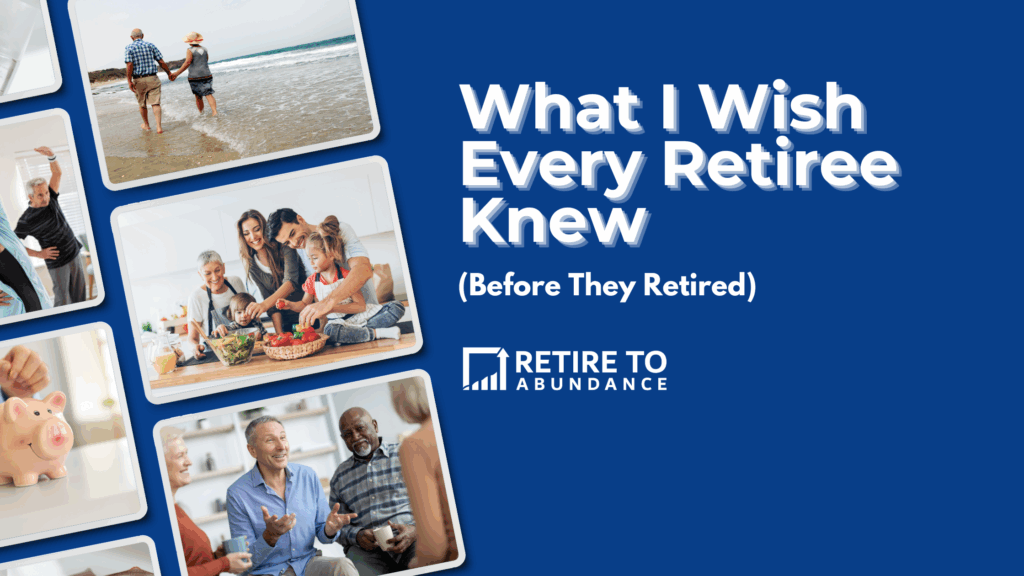Even the thought of retirement can be exhilarating. Knowing you’ll soon have the time freedom to do what you want, when you want, is enough to get even the most unimaginative person dreaming about the adventures, hobbies, and moments they’ve long put off. But along with the excitement comes some uncertainty. It’s hard to predict exactly what twists and turns retirement will bring, and that uncertainty can feel overwhelming without a clear plan.
Retirement can be one of the most rewarding stages of life, but it doesn’t just happen on its own. The best retirements are the result of years of preparation—financially, mentally, and emotionally. Over the years, I’ve walked alongside many people as they’ve made that transition, and I’ve seen what works and what can cause trouble.
When you have a clear plan in place, the difference is remarkable. You move from wondering if you’re ready to knowing you can retire with confidence. And while every plan is unique, there are certain missteps that can throw even the most prepared retiree off track. By understanding these ahead of time, you can sidestep them completely and focus on the things that matter most.
Retire to something, not from it
Too many people think of retirement as simply stepping away from a job. They picture sleeping in, slowing down, and finally being free from deadlines. While that relief is real, it often fades quickly if there is no plan for what comes next.
The question I always encourage people to ask is: What are you retiring to?
The happiest retirees I know aren’t just escaping something. They’re moving toward something they truly want. For some, that’s more time with grandkids. For others, it’s volunteering, coaching, gardening, traveling, or starting a small business. The specifics are different for everyone, but the common thread is intentionality.
If you do not fill your time on purpose, something else will fill it for you. Often that turns into boredom, restlessness, or feeling unproductive. By thinking through how you want your days to look, you give yourself a reason to get up each morning and enjoy this new season.

Too conservative is more risky than too aggressive
A common instinct for new retirees is to shift their portfolio toward safer investments. Stability is important, but taking that too far can put your long-term security at risk.
Sometimes this shows up as putting the majority of retirement savings into short-term bonds and CDs, thinking the predictable income will be enough. On the surface, it feels safe. But over time, that approach often can’t keep up with inflation. In 10 or 15 years, the same amount of income buys a lot less, and suddenly what once felt secure starts to feel tight.
If you retire in your early or mid-60s, you may need your money to last 30 years or more. Inflation will erode purchasing power, and without growth, you may find it harder to keep up with expenses in your later years.
The approach I use with clients is to match investments with time horizons. If you will need the money soon, keep it in conservative, accessible accounts. If you will not need it for many years, give it the opportunity to grow. This layered structure creates both stability and sustainability.
Being too aggressive can cause stress, but being too conservative for too long can quietly create an even bigger problem. The goal is balance.
Those early retirement years are your biggest tax opportunity
One of the most valuable windows in retirement planning happens right at the start—after you stop working but before Social Security and required minimum distributions (RMDs) kick in. For many people, this is the lowest tax bracket they will see for the rest of their life. And that creates opportunities most retirees miss.
This is when we can get proactive. Roth conversions are often at the top of the list, moving money from a traditional IRA into a Roth IRA while taxes are low. That means less in RMDs later and more tax-free income for the future.
It’s also a time to think about withdrawal strategies. Which accounts do you tap first? How do you blend taxable, tax-deferred, and tax-free income to keep yourself in the sweet spot? The order and mix of withdrawals can make a huge difference—not just this year, but 10 or 20 years down the road.
And then there’s asset location—putting the right investments in the right accounts for maximum tax efficiency. The goal is simple: keep more of what your investments earn instead of handing it over to the IRS.
This is where my role is different from a traditional CPA. A CPA is focused on the rearview mirror, reporting on what happened last year. My focus is on the windshield, looking ahead and making moves now that can lower your taxes for the next 20 or 30 years.
When you combine these strategies during those first few retirement years, the impact can be enormous. I’ve seen clients save tens, even hundreds of thousands of dollars over their lifetime simply by using this window wisely.

You Might Not Need to Keep Working
When people aren’t sure they’re ready to retire, the default answer is often, “I’ll just work a few more years to be safe.” On the surface, that sounds reasonable. More years of income means less time drawing from savings and more time for your investments to grow. But that’s not the whole picture.
I’ve worked with plenty of people who could have retired earlier than they expected, but no one had helped them look at the numbers from every angle. Once we mapped out a clear income plan, accounted for health care costs, and ran the projections, they realized they were already in a strong position. Some of them still chose to keep working, but they did so on their terms—maybe shifting to part-time, taking a lower-stress role, or starting an encore career that brought more enjoyment than their main job ever did.
Working longer can absolutely be the right decision for some people, especially if you enjoy your work or need to boost your savings. But it’s important to recognize the trade-offs. Every extra year you work is also a year you’re not traveling as much as you’d like, not spending as much time with grandkids, or not pursuing the hobbies and projects you’ve been putting off. For some, those years are the healthiest, most active ones they’ll ever have.
The key is knowing your options before you just default to “I have to keep working.” With a well-structured plan, you may find that financial independence arrives sooner than you thought. And when you know you’re financially ready, you can make the decision based on what you want for your life—not just what you think you can afford.
You don’t have to take Social Security when you retire
One of the most common misconceptions I hear is that you have to claim Social Security as soon as you stop working. That is simply not true.
Your retirement date and your Social Security start date are two separate decisions. For many clients, we intentionally separate the two. We use other income sources—like withdrawals from IRAs, 401(k)s, or taxable investment accounts—to create what I call an income bridge. The bridge provides the monthly income you need in the early years so you can delay claiming Social Security.
Why does that matter? Delaying can significantly increase your monthly benefit, and that higher benefit lasts for the rest of your life. It also increases the survivor benefit for a spouse, which can make a huge difference if one of you lives much longer than the other. For some, delaying even a few years can mean tens of thousands of dollars in additional lifetime income.
Of course, there are situations where starting benefits earlier makes sense—health concerns, needing immediate income, or other personal factors. But the point is, it should always be a deliberate decision based on your full financial picture. Coordinating the timing of Social Security with your other assets, taxes, and income needs can make the difference between a good plan and a great one.

Retirement isn’t one decision—it’s dozens of them
One of the biggest surprises for new retirees is realizing that retirement is not a single moment in time. It is a series of decisions that will unfold over many years.
The choices you make in the first five to ten years—how you invest, when you take income, how you manage taxes—will shape the decades that follow. Your lifestyle will evolve, your spending patterns will change, and your health care needs will shift. A good plan adapts with you.
This is why we revisit retirement plans regularly. It keeps your strategy aligned with your goals and ensures you are prepared for whatever changes life brings.
An ounce of…preparation
The best retirements do not happen by accident. They are built through years of preparation and fine-tuned with ongoing adjustments. The lessons here are not about reacting to problems after they happen. They are about taking steps now to prevent those problems from ever showing up.
If you are approaching retirement, the best time to start planning for these decisions is today. If you are already retired, there is still room to strengthen your plan and create more confidence for the years ahead.
You have worked too hard to reach this stage to leave the next chapter up to chance.
This post is for education and entertainment purposes only. Nothing should be construed as investment, tax, or legal advice.

